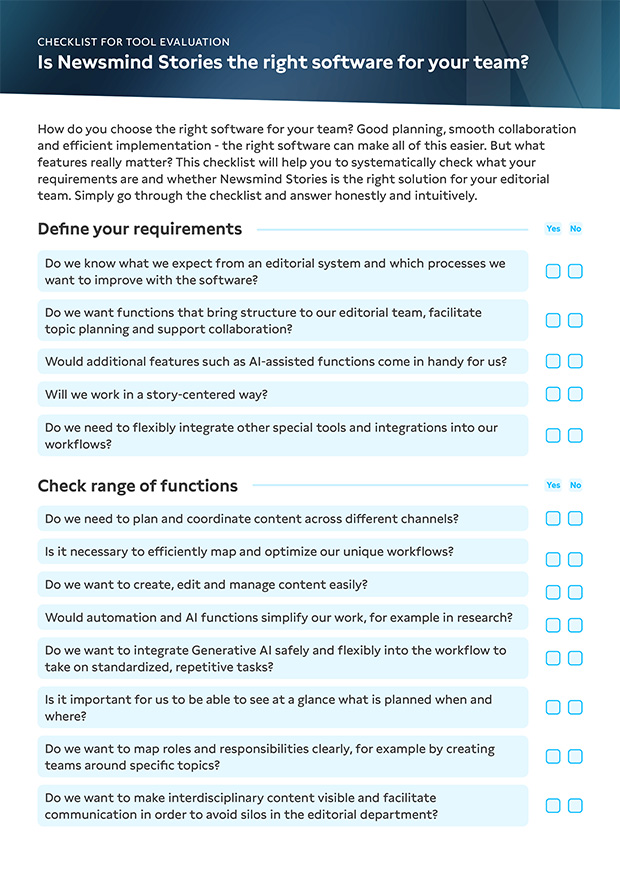The editorial planning is one of the most important tools for newsroom employees and content teams. After all, wherever content is involved, it needs to be sorted and clearly distributed across various communication channels. This is just as true for traditional newsrooms as it is for companies and other publishers. While journalistic newsrooms tend to be confronted with too many topics, corporate newsrooms may find that topics are in short supply. It is therefore essential to create an editorial plan in which editors can organise their topic planning according to their needs, i.e. which topics they would like to work on and publish in the coming days, weeks and months. Needless to say, editors can use standard tools such as Excel. However, this approach reaches its limits. Especially when editorial planning also needs to automatically take information from various digital sources into account. The solution: a tool for editorial planning.
Inhalt dieser Seite
Was ist Redaktionsplanung?
Editorial planning is the strategic core of all successful content and communication work. It translates goals and ideas into a concrete plan – with clear topics, responsibilities and timings. This allows teams to maintain an overview, avoid duplication of work and publish regularly instead of ad hoc. Good planning creates transparency, uncovers gaps and ensures that content is created in a targeted and efficient manner. It is therefore not something that can be quickly pulled out of thin air. Every media company has different requirements, depending on publication frequency, team size and content focus. Editors-in-chief should therefore clarify a number of strategic questions with their team in advance:
Zielgruppe: Wen will ich ansprechen?
Insbesondere im Corporate Newsroom, aber auch im journalistischen Umfeld sind die Mitarbeitenden gut beraten, ihre Zielgruppe genau zu kennen. Wofür interessiert sie sich? Welche Schmerzpunkte hat sie? Mit welchen Herausforderungen plagt sie sich herum? Welche Ziele verfolgt sie? Und dergleichen.
Ziel: Was möchte ich erreichen?
Mit den Zielgruppen ergibt sich in den meisten Fällen auch ein Ziel, das eine Redaktion mit ihrem Content erreichen möchte: Von Verbraucher zu informieren, aufzuklären und zu unterhalten bis zum Wecken von Aufmerksamkeit der Zielgruppe, neue Leads generieren und sie als Neukunden gewinnen.
Kanal: An welchem Touchpoint treffe ich meine Zielgruppe?
Um das zu bewerkstelligen, müssen Content Teams dafür sorgen, dass die Inhalte dort bereitstehen, wo sich die Zielgruppe aufhält. Wichtig ist, den Content an die Bedürfnisse der anvisierten Adressaten und gemäß der kanalspezifischen Konventionen anzupassen. Wie Artikel, Video- oder Audio-Beiträge auf der Website oder in Print erscheinen, unterscheidet sich für gewöhnlich voneinander und auch von Social Media oder anderen Kanälen. Das ist bei der Redaktionsplanung zu berücksichtigen.
Format: Wie bereite ich meine Inhalte auf?
Ein Thema ist – je nach Zielgruppe und Kanal – gänzlich unterschiedlich aufzubereiten. Für den Blog sind Texte bestens geeignet, während es bei YouTube natürlich Videos braucht. Für Instagram hingegen sind hochwertige Fotos und Grafiken sowie kurze Videos im Hochformat Pflicht. Sich mit den Formaten des jeweiligen Kanals zu beschäftigen, ist daher unumgänglich.
Ideen: Was will ich kommunizieren?
In der Praxis hat es sich bewährt, eine themenzentrierte Redaktionsplanung zu erstellen. Die Basis bildet zunächst eine Themenplanung unabhängig von Kanälen, die dann den Redaktionsplan befüllt. Themen lassen sich so besser über Kanäle und Formate hinweg spielen. Das spart Zeit und verbessert die Abstimmung im Team.
Was ist ein Redaktionsplan?
Ein Redaktionsplan ist das zentrale Steuerungselement für Redaktionen. Er bündelt alle relevanten Informationen zur Content-Publikation und hilft dabei, Veröffentlichungen zu strukturieren und zu terminieren. Ob im Newsroom oder im Content-Marketing – ein durchdachter Redaktionsplan sorgt für Übersicht und effiziente Abläufe.
Er enthält nicht nur Themen und Veröffentlichungstermine, sondern auch Verantwortlichkeiten und wichtige Arbeitsschritte. Je nach Veröffentlichungsfrequenz – in journalistischen Redaktionen oft Dutzende oder Hunderte Beiträge pro Tag – wächst die Planung schnell an. Umso wichtiger ist es, Prozesse klar zu definieren und praktikabel zu gestalten.
Viele Redaktionen planen mehrere Monate im Voraus. Daher hat sich auch der Begriff „Redaktionskalender“ etabliert. Feste Themen und Serien bilden das Grundgerüst, während flexible Slots Platz für aktuelle Ereignisse lassen. So bleibt die Berichterstattung aktuell und reaktionsfähig.
Auch Unvorhergesehenes gehört zur Planung. Eine gute Redaktionsplanung lässt sich anpassen und integriert wiederkehrende Events wie Feiertage oder Branchenveranstaltungen. Das ermöglicht es, diese Anlässe gezielt mit passenden Inhalten zu bespielen.
Kurz gesagt: Ein Redaktionsplan ist mehr als eine Liste. Er ist das strategische Werkzeug, das Medienhäuser brauchen, um strukturiert, flexibel und zielgerichtet zu arbeiten. Aber vor allem gibt es nicht den einen richtigen Weg, einen Redaktionsplan zu erstellen.
Creating an editorial plan - what are the different approaches?
There are different approaches to creating an editorial plan, which differ in terms of their complexity. And while a good editorial plan provides structure in any form, without the right tool, implementation can quickly become confusing. It is therefore worth taking a closer look at the various approaches to editorial planning and the appropriate tools.
Papierbasierte Redaktionsplanung
Insbesondere dann, wenn die Mitarbeitenden im Corporate Newsroom vor der Herausforderung stehen, ihren ersten Redaktionsplan zu erstellen, kann es sinnvoll sein, sich zunächst im kleinen Kreis für ein Brainstorming zusammenzusetzen. Und ja, Papier und Stift haben hier immer noch nicht ausgedient, um im Rahmen eines Kickoffs oder Workshops erste Ideen festzuhalten. Idealerweise verwendet das interdisziplinäre Team dabei ein Flipchart, auf dem es Post-its mit Ideen anbringt und bedarfsgerecht clustert. Die Ergebnisse der analogen Themenplanung sind in der Regel recht gut, wenngleich es unweigerlich zu einem Medienbruch kommt. Schließlich sind die Ideen am Ende in einen digitalen Redaktionsplan zu überführen.
Tipp: Anstatt echte Post-its eine einfache digitale Planung mit Boards und Listen anfangen, zum Beispiel in Trello. Teams können Themen und Brainstorming auch digital organisieren.
Redaktionsplanung mit Excel & Co.
A simple solution for editorial teams that do not want a large software overhead remains the classic editorial calendar with Excel spreadsheets or Google Sheets. If these are accessible as an editorial plan via the browser for all authorized users, several employees can work with the plan in parallel and the editorial planning remains flexible to a certain extent. Excel can provide a clear structure, but becomes inflexible if the complexity increases.
Redaktionsplanung aus dem Content-Management-System heraus
In addition, some content management systems (CMS) support the creation of to-do lists. Admittedly, such a list does not replace professional topic planning. Nevertheless, it can be very helpful for assigning work and proofreading tasks to a person, for example, and for ticking off tasks once they have been completed. Depending on the CMS, it is also possible to save smaller input texts directly.
Redaktionsplanung mit einem professionellen Redaktionsplanungs-Tool
Many editorial offices combine the methods mentioned, wanting to plan for the long term but also wanting to leave room for spontaneous content. In order to be able to work with all events, volumes of information and the number of information sources – from established sources such as news agencies, research networks, press spokespersons, event portals and authorities to the personal contacts and research of their own editors and social media posts – modern editorial offices rely on software for their topic and editorial planning. The right software helps to keep an eye on topics and deadlines, assign responsibilities and manage content efficiently. It is important that the tool can be seamlessly integrated into the daily work routine and reduces the workload. Editorial systems with integrated AI are particularly good at taking work off your hands. An AI-based editorial planning tool such as Newsmind Stories, for example, not only monitors countless digital sources and streams. It also pre-sorts the incoming reports, summarizes them in topic clusters and finds topics and trends on the fly.
Ist Newsmind Stories die richtige Software für euer Team?
Our checklist will help you to check what your requirements are and whether Newsmind Stories is the right solution for your team.

Welche Informationen gehören in einen Redaktionsplan?
A variety of aspects need to be taken into account when planning editorial work – from ideas and events to tasks and deadlines to responsibilities and accountabilities. The following applies: Good planning is half the battle. Ideally, the editorial plan should be so well developed that one look at it is enough to know which topics are to be published in three or five months’ time. It is therefore advisable to take the following information into account when content teams create an editorial plan:
How does an editorial planning tool support topic planning?
Gerade für Redaktionen und Newsrooms, die ihren Input aus einer Vielzahl von Quellen – auch digitalen – beziehen, ist ein webbasiertes Tool für die Redaktionsplanung ein äußerst nützliches Werkzeug. Denn es kostet Redaktionen viel Zeit, aus der Fülle verfügbarer Informationen und Quellen die für das jeweilige Medium und seine Zielgruppe relevanten herauszufiltern und dabei den Überblick über alle Themen und Geschichten zu behalten, um nicht im Versionschaos oder in Doppelarbeit zu versinken. Dass sich diese Aufgabe nicht mehr manuell auf Post-Its oder in einfachen Listen bewältigen lässt, liegt auf der Hand. Ein Tool für die Redaktionsplanung reduziert stattdessen Last-Minute-Stress, verbessert die interne Abstimmung und stärkt die redaktionelle Linie. Wer strategisch plant, arbeitet effizienter – und schafft gleichzeitig mehr Raum für kreative Ideen.
Wer noch mehr Unterstützung sucht, setzt inzwischen auf KI-unterstützte Systeme. Denn auch gängige Tools zur Redaktionsplanung stoßen beim Umgang mit Millionen einzelner Informationen aus Dutzenden Quellen schnell an ihre Grenzen. Wie ein Redaktionsplanungs-Tool auf Basis von künstlicher Intelligenz hier für Entlastung sorgen kann? Die Software Newsmind Stories etwa automatisiert viele sonst sehr repetitive und zeitintensive Aufgaben, zum Beispiel in der Recherche und im Monitoring. Sie hilft auch dabei, Meldungen nach Relevanz vorzusortieren und ähnliche Meldungen des Wettbewerbs anzuzeigen. Außerdem unterstützt Generative KI beim Erstellen von Posts oder Artikeln.
Übrigens: In unserer Infothek findest du noch mehr zum Thema KI im Journalismus und wie Anwendnungsfälle aussehen können.
Our editorial planning software in action
Under the name Plan.R, WDR uses our AI-based Newsmind Stories software to plan topics efficiently and across channels – i.e. for television, radio and social media.
Redaktionsplanung – unser Fazit
Newsrooms of all sizes cannot avoid professional editorial planning. The more complex and extensive the requirements in terms of topic planning and editorial planning are, the more indispensable an editorial calendar is. In the hustle and bustle of day-to-day operations, it serves as a support so as not to lose the common thread in content collection, structuring, scheduling, preparation and distribution. In addition, professional editorial planning is needed to optimise the distribution of individual to-dos among the available resources. For all content-specific tasks, an editorial planning tool demonstrates its strength and increases the efficiency of newsrooms on a daily basis.
Weitere interessante Artikel, die du nicht verpassen solltest





